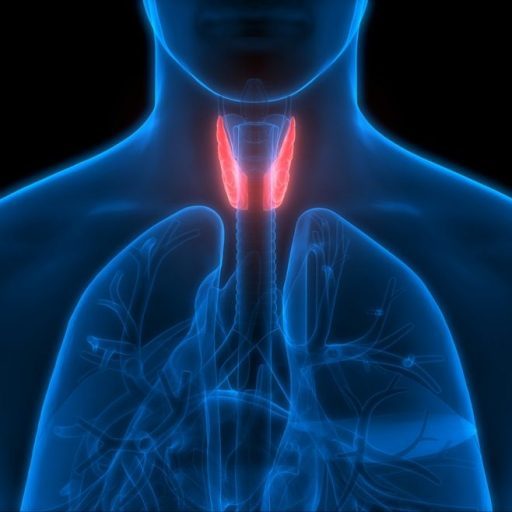Although George H.W. Bush, the forty-first President of the United States, was the fifth oldest president to hold that office, he was considered by many to be one of the most physically fit presidents in American history. Therefore, it was all the more shocking when, at the age of 66, President Bush was hospitalized because of a heart condition. When medical tests confirmed that an autoimmune thyroid disease was the real culprit, the public was even more puzzled.
While jogging around the grounds of Camp David on a Saturday afternoon in May 1991, the President experienced shortness of breath, tightness in his chest, and a general feeling of fatigue. A White House physician examined him and discovered that the President’s heart was beating rapidly and irregularly. Realizing that the President was experiencing atrial fibrillation, he immediately arranged for the President’s admission to Bethesda Naval Hospital.
When giving information for his medical history, President Bush stated that he had been feeling increasingly tired during the two weeks preceding his hospitalization. In addition, he had lost nine pounds in two months, and his handwriting had deteriorated. Physical examination revealed a fine tremor of his hands and a slightly enlarged thyroid gland (goiter). Initial tests ruled out underlying heart disease as the cause of his atrial fibrillation. Further testing revealed that the President was suffering from hyperthyroidism (too much thyroid hormone) caused by Graves’ disease. The excessive hormones were overstimulating the President’s heart and disrupting its normal rhythm.

Graves’ Disease
Graves’ disease is an autoimmune disease and the leading cause of hyperthyroidism in this country. To date, researchers have not been able to discover what actually causes the immune system to go awry, but they have discovered some revealing characteristics of autoimmune disorders. In general, an autoimmune response occurs when the immune system incorrectly identifies parts of healthy cells in the body as “invaders” and produces antibodies to attack these cells. There seems to be a genetic predisposition, especially among women, to develop autoimmune diseases. In addition, people with one autoimmune disease are more likely to develop other autoimmune disorders.
Graves’ disease can affect the thyroid gland, the eyes, and the skin. In Graves’ hyperthyroidism, antibodies attack sites in the thyroid gland that capture TSH (thyroid stimulating hormone). These antibodies then begin to function like TSH; however, they stimulate the thyroid gland to make and secrete excessive thyroid hormone. Excessive thyroid hormone can cause any number of signs and symptoms. The most common signs and symptoms of Graves’ hyper-thyroidism are an enlarged thyroid gland (goiter), fatigue, nervousness, irritability, increased sweating, an inability to sleep, and weight loss.
As noted, President Bush did not experience some of the more common symptoms of Graves’ hyperthyroidism. In fact, patients over the age of 60 do not typically have the same signs and symptoms as younger patients. Instead, they may have only one organ affected, such as the heart.
Hyperthyroidism Treatment
President Bush, along with his medical practitioners, reached a consensus that his hyperthyroidism required treatment that was safe, swift, definitive, and enduring. As a result, he ingested a dose of radioactive iodine orally shortly after his hospital admission. Hyperthyroid individuals receiving treatment via radioactive iodine or surgery might confront an infrequent health emergency known as a thyroid storm. This potentially fatal condition is precipitated by an abrupt release of excessive thyroid hormone from the thyroid gland. Fortunately, strategic administration of specific drugs can impede this sudden release. Consequently, two days post his radioactive iodine intake, President Bush initiated a regimen of SSKI (potassium iodide), consuming four drops thrice daily over a ten-day span to mitigate the risk of a thyroid storm.
 Even though his endocrinologists believed that the positive effects of the radioactive iodine would be noticeable within one or two weeks, they knew it would take two to three months before the President’s thyroid hormone level would return to normal (euthy-roidism). Because of Mr. Bush’s position and responsibilities as President, it was especially important to reduce his thyroid hormone levels as soon as possible.
Even though his endocrinologists believed that the positive effects of the radioactive iodine would be noticeable within one or two weeks, they knew it would take two to three months before the President’s thyroid hormone level would return to normal (euthy-roidism). Because of Mr. Bush’s position and responsibilities as President, it was especially important to reduce his thyroid hormone levels as soon as possible.
By choosing SSKI to prevent thyroid storm, his doctors were also giving the President a medication that starts to reduce thyroid hormone levels within hours and reaches its full effect within a few days. PTU (propylthiouracil) and Tapazole® are other drugs sometimes given to prevent thyroid storm. However, it can take seven days before these drugs start to reduce hormone levels and two to three weeks to reach their full effect.
Dr. Allen M. Ross, the cardiologist caring for President Bush, treated the atrial fibrillation with a combination of drugs: procainamide and digoxin to control the irregular heartbeats and Coumadin® to protect against blood clotting. As the President’s thyroid hormone levels became normal, these drugs were tapered off.
Understandably, the President was concerned that his medical problems would affect his work schedule. Although he was allowed to return to work, he was advised not to overexert himself. His physicians told him that he would continue to feel tired until his thyroid hormones approached a normal level. However, they assured him that he could resume his full level of activity in one to two months. For several weeks, both his thyroid levels and his heart were monitored very closely. As anticipated, within a few months, the President’s thyroid gland was no longer producing enough thyroid hormone, causing him to become hypothyroid (too little thyroid hormone). At that point, he began taking thyroid hormone replacement.
Fortunately, President Bush rebounded quickly and completely. According to Dr. Ross, “President Bush was extremely fortunate to have had a completely curable form of heart disease, one caused by an excess of thyroid hormone, which quickly responded to treatment. Most heart patients are not so lucky.” The radio-active iodine treatment effectively ended the President’s hyperthyroidism, and brand-name levothyroxine taken daily maintains the proper level of thyroid hormone (euthyroidism) in the former President.
When the public became aware of the President’s thyroid disorder, there was a flurry of speculation about autoimmune disease in the White House. Eighteen months before the President’s ordeal, Barbara Bush was also diagnosed with Graves’ disease. Unlike her husband, she also developed Graves’ eye disease (see The Thyroid Connection, Volume II, No. 1). The odds of both husband and wife developing the same autoimmune disease over their lifetime are more than one in 10,000. The odds increase to one in three million that it could happen within a two-year period!
When Millie, the cherished canine of the Bush family, fell ill with lupus, another autoimmune disease, speculation arose about possible contaminants in the White House water. Nevertheless, his doctors determined that it was most probably a coincidence that President Bush, Mrs. Bush, and Millie were all diagnosed with autoimmune diseases.
Having stepped away from the public sphere, George Bush remains active, leading a vigorous and adventurous lifestyle. His personal doctor, Dr. Benjamin Orman, attests that, “Mr. Bush belies his age, maintains excellent health, works out regularly, and sustains a brisk pace of life.” Astoundingly, on April 1, 1997, President Bush made good on a promise to himself that he’d made during World War II when a burning bomber forced him to eject and parachute to safety. At 72, showcasing his enduring vitality, he leapt from an airplane, soared through the skies, pulled his parachute’s ripcord, and gently descended to Earth.
Through their personal experiences and candidness about Graves’ disease, the Bushes have drawn attention to a condition that impacts millions of Americans. Essential conversations regarding the nature and management of the disease have been fostered, enhancing public knowledge and understanding. By publicly discussing their thyroid issues, the Bushes have once more exemplified their extraordinary dedication to serving others.






